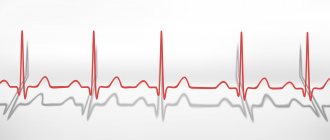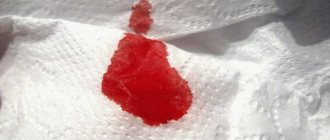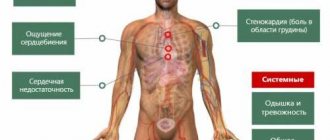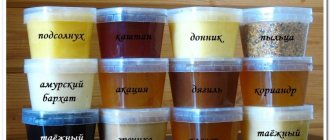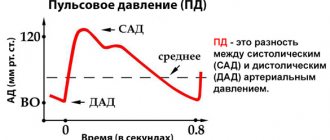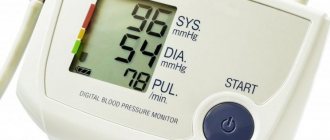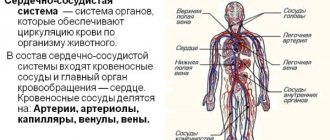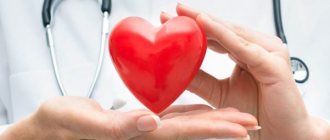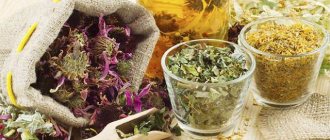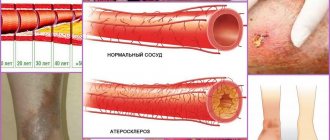In this article we will look at the reasons and ways to increase lower pressure at home. We will also give some tips on how to avoid this.
One of the most vital indicators in our body is blood pressure. It reflects how fully the cardiovascular system works and responds to the slightest pathological changes in it. Low blood pressure is considered especially dangerous for the heart. Therefore, we should consider what methods can be used to increase it and how to prevent further decline.
What is the danger of pathology
Diastolic hypotension is extremely rare and is usually a signal of severe pathology. The danger of the situation lies in the fact that when the lower pressure indicator decreases (to 60 units or less), the ability of the myocardium to pump the volume of blood required by the organs and tissues into the bloodstream occurs. Lack of nutrients and oxygen leads to hypoxia, dysfunction of the kidneys, brain, eyes, and other internal organs.
This is fraught with the development of cardiovascular pathologies:
- arrhythmias;
- encephalopathies;
- ischemia of the heart, brain;
- attacks of angina pectoris;
- heart attacks, strokes;
- dementia.
There is another danger - injuries. Low DBP provokes dizziness, falling, and hitting nearby objects. Therefore, raising the lower pressure is as important as it is difficult.
What to do if lower blood pressure is low in an adult or elderly person
If alarming symptoms occur, adult patients should consult a doctor to determine the causes and exclude serious pathologies. This is especially important for older people, because more often the signs hide serious illnesses.
The likelihood of myocardial infarction is high, even if there is no pain in the sternum. To increase the lower indicator, means are used to ensure a gradual change in pressure. With a sharp change in blood flow in the vessels, bleeding may occur.
In a pregnant woman
The danger of low blood pressure in a pregnant woman is the insufficient delivery of nutrients and oxygen to the fetus. Medicines at this stage are prescribed in limited quantities, so you should initially try non-drug treatment:
- walks in the open air;
- elimination of physical and nervous stress;
- massage;
- swimming;
- dietary adjustments.
Traditional medicine should be treated with caution, as some plants provoke bleeding.
Reference! To stabilize low blood pressure, pregnant women are allowed to use decoctions of calamus, juniper, St. John's wort, and chicory.
Emergency help
A sharp drop in lower pressure is accompanied by characteristic symptoms:
- darkness in the eyes;
- headache;
- disorientation in space;
- fainting;
- speech disorders;
- loss of consciousness.
A marker of diastolic hypotension is considered to be a decrease in body temperature below 36°C. If such symptoms appear, the patient should be laid horizontally, wrapped in a blanket, leaving the head and chest open. Elevate your legs by placing a cushion under them, this will help blood move more actively along the bloodstream to the brain. As a medicine, give a glass of strong sweet tea, any tonic tincture (10 drops per glass of water).
Coffee is prohibited because it causes increased heart rate, which will negatively affect the heart. But you can give a slice of dark chocolate containing at least 65% cocoa products. If there is no result within half an hour, an ambulance is called.
How to increase lower pressure without raising upper pressure: instructions, tips
From this article you will learn why, before raising your lower blood pressure, you must find out the reason for its decrease. How to raise only the lower pressure without raising the upper one.
Author of the article: Nivelichuk Taras, head of the department of anesthesiology and intensive care, work experience 8 years. Higher education in the specialty “General Medicine”.
People with high blood pressure are 60–70% more likely to have complaints than people with low blood pressure. Therefore, many more drugs have been invented for hypertension than for hypotension. And when it comes to lowering lower pressure, many experts completely shrug their shoulders. This is because this can be done in very rare cases when diastolic hypotension is really a signal of severe pathology.
But there is always a way out of any situation, even the most difficult one. In the case of an isolated decrease in lower pressure, consistently follow and understand only three rules:
Is it possible to raise lower blood pressure in isolation?
There are no special medications to increase lower pressure in isolation, without raising the upper one. The relationship between DBP and SBP dictates the following tactics if it is necessary to reduce only the diastolic indicator:
- it is necessary to adequately assess the condition of the hypotensive patient;
- be sure to find the root cause (and it may be the most serious), that is, be completely examined in a clinic;
- select an individual treatment regimen based on the results of the data obtained.
Diastolic pressure characterizes the contractility of the myocardium. This means that we should look for the reason that violated it. Since lower pressure is called renal pressure, very often the root cause of diastolic hypotension is precisely a disruption in the functioning of the urinary system. Renal ischemia, chronic renal failure, nephritis of various origins. Only by eliminating the identified pathology can the lower pressure be brought back to normal without affecting the upper pressure.
Diastolic hypotension implies two development options: without any symptoms and with certain clinical symptoms. If there are no complaints, then no treatment is required (for tonometry readings up to 55 units). The presence of complaints with a large pulse difference (more than 60 units) deserves attention in the following cases:
- when SBP = 135-140 units and DBP is below 60, this is fraught with migraines, a feeling of chronic fatigue, and weakness, which indicates vascular disorders during normal myocardial function;
- if SBP is at the lower limit of normal (100-110), and DBP is significantly reduced (less than 40), this indicates that the joint work of the heart and blood vessels is pathologically impaired.
Sometimes persistent isolated diastolic hypotension indicates aortic valve insufficiency, which requires emergency assistance and surgical intervention. A simultaneous decrease in upper and lower pressure is a consequence of hormonal imbalance or VSD.
Symptoms of low lower pressure
A sharp decrease in lower pressure can cause a pre-fainting state or even fainting itself. It is especially dangerous if there is a large gap between the upper and lower limits.
- The main symptoms of hypotension are: weakness;
- absent-mindedness;
- poor sleep with difficulty waking up;
- depressed mood;
- shortness of breath and heart rhythm disturbances that occur even with light exertion;
- dizziness, especially after a sudden change in body position;
- pale skin;
- sweating;
- weather dependence.
Weakness and dizziness are some of the main symptoms of low blood pressure
Medicinal correction at home
An isolated decrease in diastolic reading occurs in a maximum of 10% of cases. In the remaining 90%, this is a combined change in the upper and lower levels, therefore, when prescribing drugs that promote the growth of DBP, one cannot ignore the level of systolic pressure.
For example, caffeine-containing drugs (Citramon, Pentalgin-N, Caffeine, Farmadol) will easily raise the diastolic reading, but if diastolic hypotension is combined with systolic hypertension, a crisis may occur, since caffeine will raise the already high systolic pressure.
Therefore, doctors prefer to prescribe beta blockers to increase low lower pressure: Coronal, Concor, Micardis, Telmisartan, Losartan or calcium antagonists: Isoptin, Verapamil, Finoptin, Diacordin. They additionally exhibit antiarrhythmic properties, so their self-prescription is unacceptable. A complete clinical and laboratory examination is required.
The drugs are prescribed in individual dosages depending on the general condition of the patient and his age. This is especially important for the elderly or those people who suffer from diseases of the vegetative-vascular system, heart, and kidneys.
In emergency cases, when there is a critical decrease in blood pressure, the following is administered: Prednisolone, Dexamethasone, Cordiamin, Dopamine, Mezaton.
Adaptogens
Low blood pressure can be raised using a large group of herbal or synthetic medicines that stimulate the human immune system and increase its ability to withstand negative influences. These include:
- ginseng – prevents stroke, improves immunity;
- basil is an excellent antioxidant, removes free radicals, toxins, rejuvenates the body, is used in Ayurscience, increases vascular tone, improves concentration, memory, and improves mood;
- ashwagandha (Chinese ginseng) – relieves anxiety by correcting cortisol in the bloodstream, exhibits antioxidant properties, rejuvenates cells, improves memory, prevents Alzheimer’s disease, alleviates menopausal symptoms;
- Eleutherococcus – stimulates the functioning of the heart and blood vessels, reduces sugar and cholesterol in the vascular bed;
- Schisandra is considered an excellent detoxifier and antioxidant;
- Rhodiola rosea – provides protection against stress, relieves fatigue;
- Astragalus is a legume, detoxifier, antioxidant, supervises the endocrine glands;
- licorice root – soothes, stimulates endurance, improves immunity;
- Schisandra (Chinese lemongrass) increases the resistance of internal organs to negative influences;
- reishi – the mushroom stimulates the immune system, prevents cardiovascular pathology;
- Peruvian maca – balances hormonal levels;
- rosemary relieves stress, improves the functioning of the cardiovascular and digestive systems.
Adaptogens play a significant role in raising lower low blood pressure, but are prescribed only on the recommendation of a doctor, since they do not have an isolated effect on DBP. Among synthetics we can note Pantocrin, Tonginal. These drugs are taken for no more than two weeks, since an overdose may lead to an increase in SBP with a hypertensive crisis.
Vitamin and mineral complexes
A deficiency of minerals and vitamins can provoke a decrease in diastolic blood pressure. They are an alternative to a balanced diet. Use:
- Pikovit:
- Doppelhertz OMEGA 3;
- Complivit,
- Supradin;
- Vitrum;
- Centrum;
- Alphabet.
They are prescribed only by a doctor after a complete examination of the patient, since an overdose of calcium, potassium or magnesium, for example, can lead to serious neurological, renal, and cardiac disorders.
Upper and lower pressure increase together
If you have been examined, but have not found any severe abnormalities in the heart or aortic valve, the most likely reasons for the decrease in lower pressure may be vegetative-vascular dystonia and hormonal imbalance. In 75% they occur in young women. Their upper pressure is either also low or unstable - constantly changing from normal to low. Therefore, the need to increase only the lower indicator without influencing the upper one is irrelevant.
In general, systolic is more important than diastolic (with the exception of aortic regurgitation). Its increase can compensate for vascular insufficiency, which is indicated by low lower pressure. Therefore, do not try to increase them separately. This is impossible and unnecessary.
Useful practical recommendations for increasing blood pressure
But what to do if diastolic hypotension is caused by excessive vasodilation against the background of vegetative or hormonal dystonia? Most of these people suffer from general weakness, sweating, lethargy, shortness of breath, poor coordination of movements, and decreased brain activity. The following tips may help you:
- Contact an endocrinologist, take blood tests for female sex hormones and thyroid hormones (TSH, T3, T4), general blood and urine tests. If hormone deficiency is detected, it is necessary to take replacement drugs based on them. Thus, you will not only raise your lower blood pressure, but also eliminate all other manifestations of hormonal deficiency.
- If the cause is vegetative-vascular dystonia, contact a neurologist or psychotherapist. There is no need to be shy, afraid, or even more so ignore these specialists. In 50% of cases, after prescribing neurotropic drugs and various psychotherapeutic sessions, it is possible to reduce or completely eliminate the manifestations of dystonia. In particular, lower pressure can normalize without a pronounced increase in upper pressure.
- Don’t focus on your problem - the more you think that you are seriously ill, the more this will be visible in real life. No matter how hard it is for you, try to distract yourself with something pleasant, forgetting about hypotension.
- You can take adaptogens - drugs that increase overall vitality: tincture of ginseng, eleutherococcus, Pantocrine, Tonginal. They can increase lower blood pressure.
- In case of a critical decrease, the following drugs are administered: Prednisolone, Dexamethasone, Cordiamin, Dopamine, Mezaton for emergency care.
- Drink coffee in the morning. Although this product increases systolic and diastolic numbers equally, do not be afraid to use it even if the upper limit is at the maximum limit of normal. Be sure to carry out control tonometry throughout the day. If the lower pressure numbers can be raised, but the upper pressure rises above 140 mmHg. Art., you will either have to give up coffee altogether or reduce the dose.
- Eat well and regularly: hearty food, sweets, meat dishes - all this is a powerful source of energy. Along with its influx, all tonic influences in the body are activated, which is accompanied by an increase in pressure.
- Don't skip salt and liquids. One without the other, they are ineffective in increasing pressure, but together they are able to fill the vessels with fluid, which will have a positive effect on diastolic hypotension.
- Be active. Systematic dosed physical activity (physical therapy, running, sports games, walks in the fresh air, hiking) activates cardiac activity and vascular tone. This will eliminate hypotension over time.
Diet
Walnuts with milk.
You can increase low blood pressure at home with a diet (fasting is excluded). A balanced diet involves inclusion in the daily menu:
- loaves with bran;
- rye bread;
- jacket potatoes;
- celery in all types;
- cabbage of different varieties;
- legumes;
- nuts;
- grapes;
- garlic;
- tea with lemon;
- chocolate;
- carrot, beet juice;
- dairy products.
It is important to ensure the supply of the required amount of fiber, iodine, and salt. A useful product for lowering blood pressure is seaweed, as well as citrus fruits, especially grapefruit.
Fatty foods (lard, fatty meats, duck, chicken with skin, deep-fried dishes), cholesterol-rich foods (brains, liver, kidneys, other offal, sausages, sausages, raw smoked and boiled sausage), and onions are removed from the diet. Anything containing caffeine and alcohol is limited to a minimum.
There is a separate question about the use of alcoholic beverages. Indeed, dry red wine or cognac can cope with the problem once. But (!) alcohol abuse will lead to neurological and cardiovascular disorders, which will only worsen hypotension and provoke its progression.
Alcohol standards for low blood pressure
| Drink | Norm for women | Norm for men |
| Red dry | 120 ml | 150 ml |
| White dry | 100 ml | 120 ml |
| Cognac | 30 ml | 50-60 ml |
| Vodka | 30-40 ml | 50-70 ml |
Strong drinks have the ability to reduce sugar.
Causes of low diastolic pressure
Lower blood pressure - diastolic (DBP), also called pulse or renal, is responsible for the work of the left ventricle of the heart, which pumps blood into the aorta. The indicator is measured during relaxation of diastole (heart muscle). A stable decrease in DBP occurs with pathological disorders in the kidneys, cardiovascular system or endocrine system. A sudden decrease in value due to deterioration of the condition may be signs of:
- infection or intoxication;
- suffered stress;
- overwork caused by physical activity;
- acute allergic reaction;
- perforation of an ulcer or internal bleeding.
Lower blood pressure decreases with diabetes mellitus, brain tumors or oncological processes, regardless of location, with bronchial asthma. Immediately after a heart attack or perforation of an ulcer, most often blood pressure rises sharply, and then DBP drops to critical levels.
Massage
It helps to tone blood vessels, but it must be done correctly. Acupressure is effective for hypotension, but it is better to entrust it to a professional, since the key to success is accurate knowledge of the location of the points.
Massage of the feet and head helps a lot. You can do this yourself. The earlobes are pulled down, and then lightly rubbed, moving to the head area. Everyone does the fingertips. Massage the area of the neck and back of the head in different directions from the spine.
It helps to increase lower pressure if you first rub your palms, and then put one on your forehead and the other on the back of your head and sit there for a few minutes until the feeling of pleasant warmth disappears. Then, you can rub your palms again, put one on your chest, the other on your forehead, and again for a few minutes of rest. You can rub your chest yourself in a clockwise circular motion, either decreasing or increasing the radius.
It’s a good idea to lightly pinch your eyebrows from the bridge of your nose to your temples.
The feet are rubbed until a feeling of warmth appears.
A super exercise for low lower pressure is “propping up the skies.” Sitting comfortably on a chair, you need to stretch your arms up, as if you were supporting the sky, and freeze in this state for half a minute. If it’s difficult, then rub your palms, clasp them, put them on the back of your head, and sit like that for half a minute.
Correctly assess your condition
In the case of diastolic hypotension, it is appropriate to consider two situations:
- When this condition is accompanied by symptoms.
- There are no complaints, hypotension is detected only with tonometry.
If there are no complaints
If you felt good before tonometry, but only after the procedure you learned that your lower pressure was low and started thinking about how to increase it, this means that there are actually no problems. You should not be negative, since the condition will definitely worsen, and you will find, if not all, then most of the symptoms of hypotension.
Folk remedies
The following folk remedies will help bring your heart rhythm back to normal without increasing your upper blood pressure:
- Cornflower infusion. Cornflower flowers, bearberry, crushed licorice root in a ratio of 1:5:2, 20 g of the mixture per glass of boiling water, leave for 8 hours, drink on an empty stomach, a tablespoon three times a day, for a month.
- Sea buckthorn infusion. Fresh or dry berries - 50 g, add a spoonful of tansy, yarrow, 2 spoons of immortelle, pour everything with a liter of boiling water, leave for an hour, drink a glass, a couple of times a day, course from 14 to 45 days depending on the effect (you can add immortelle) .
- Infusion of prickly steelweed. Stalnik is practically the only natural remedy that raises lower blood pressure in isolation; it is indicated for chronic diastolic hypotension: mix a teaspoon of stalnik and tansy (tonifies blood vessels), pour a glass of boiling water, leave for half an hour, divide into two doses, take before meals, course - two weeks (you can add immortelle)
You can use ready-made pharmacy tinctures of herbal adaptogens.
Providing assistance yourself
If the lower pressure has dropped to critical levels, the victim should be given immediate assistance. Symptoms that indicate that the condition is critical:
- weakness;
- pale skin;
- nausea turning into vomiting;
- disorder of consciousness.
Most often, systolic blood pressure (SBP) and DBP decrease together, so you must act quickly to save the patient's life:
- They call an ambulance.
- The patient is placed with his legs slightly elevated to encourage blood flow to the brain. Women unfasten buttons, belts, and bra hooks to make breathing as easy as possible.
- If the patient is nauseous, turn his head to the side so as not to choke on mucus and vomit. The oropharynx may need to be cleared. To do this, wrap 2 fingers with a sterile bandage or, if this is not at hand, with a clean handkerchief.
- Open vents, windows, doors to ensure a stable flow of air. Care must be taken not to provoke the development of a cold. When it is cold and the patient is shivering, he is first covered with something light and warm, for example, a blanket.
- Brew strong tea for the victim, add sugar or glucose. You can give a tincture of ginseng or eleutherococcus - 10-14 drops per 100 ml of water.
- Blood pressure measurements are carried out every 15-20 minutes.
If there are no reasons for hospitalization, the condition has stabilized, it is recommended (after DBP has increased) to take a contrast shower. The duration of the water procedure is no more than 1.5-2 minutes, the temperature mode is switched every 20 seconds. The effectiveness of acupressure has been proven. The neck area is treated, in the projection of the carotid artery, the central part of the back of the head, areas under the cheekbones, and the upper points of the shoulder girdle. The influences are carried out with the pads of the fingers, pressing rhythmically. Active points are located in these places. The duration of the massage is 3-5 minutes.
What not to do
When providing emergency assistance, there are a number of rules that cannot be broken:
- bending or other physical exercises are excluded, this can cause cerebral hypoxia and fainting;
- Do not give ammonia to sniff, it can cause a migraine attack;
- drugs that increase blood pressure are prohibited unless they have been previously agreed upon with the doctor;
- Alcohol is contraindicated, since ethyl alcohol dilates blood vessels and leads to an even greater drop in blood pressure;
Diastolic hypotension or low blood pressure can be asymptomatic for a long time, so a sharp drop in blood pressure is always unexpected, and therefore a priori requires knowledge of the basic rules of first aid.
Effective Treatments
Drugs that increase blood pressure
Caffeine tablets - "Citramon", "Pentalgin" or "Askofen", which should always be at home, will help to increase low blood pressure without increasing high blood pressure. The drugs “Concor” and “Coronal” correct the functioning of blood vessels. "Isoptin" and "Micardis" will help with fainting conditions. "Pantocrine" and "Tovinal" help to quickly increase lower blood pressure.
To regulate renal pressure, the underlying renal pathology should be treated
In order to increase heart pressure, you cannot do with just pills. To prevent blood pressure from dropping, it is recommended to drink herbal preparations presented in the table for therapeutic purposes:
Reasons for low blood pressure
There are a number of reasons that provoke a systematic decrease in pressure. This:
- cardiovascular diseases;
- diseases of the genitourinary system;
- infectious diseases;
- allergic reactions to taking medications, insect bites, snake bites;
- oncology;
- physical overload;
- stress;
- endocrine diseases;
- pregnancy.
Sometimes pathology leads to the fact that the pressure drops constantly. In other cases, a similar picture is observed from time to time. But it is necessary to help the body in both situations.
How to permanently increase blood pressure without medications
We repeat: with the help of a doctor who will determine the causes of your condition and prescribe a treatment regimen. To relieve symptoms, your doctor will prescribe medications that return low blood pressure to normal.
However, you can help your body by making a few lifestyle changes. Here's what doctors advise Low Blood Pressure Diagnosis & Treatment to do for hypotension:
- Drink more water, especially if it's hot outside or you have a fever.
- Limit your alcohol intake. If possible, give up alcohol altogether.
- Exercise regularly or at least walk more: physical activity improves vascular tone.
- Try not to stand in one place for a long time. If you have a standing job, warm up more often: walk. squat, jump, dance.
- Do not take long hot baths. A healthier option is a contrast shower.
- Reduce the amount of carbohydrates in your diet. If you want something sweet, eat fruit.
- Eat small meals 4-5 times a day.
Pills that increase heart pressure
Among the majority there is an opinion that low blood pressure, or hypotension, does not pose a threat to life. But doctors are not so optimistic and claim that low blood pressure is a symptom of a serious heart disease. There is no point in waiting for the condition to normalize. You need to know basic ways to increase your heart pressure. But professional medical help cannot be neglected. The problem is serious and requires careful diagnosis and treatment.
However, the parameters 90/60 are low pressure. The condition is characterized by certain symptoms:
How to raise heart pressure. Folk recipes
At home, ginger root is exactly the remedy that will help quickly raise blood pressure. The effect of this spice stimulates the supply of oxygen to brain cells and the body's protective functions, helping to increase physical endurance. For these purposes, it is necessary to consume pickled ginger 3-4 times a day. An alternative option is ginger tea. You need to take 40 grams of ginger, pour boiling water over it and let it brew. Take three times a day after meals.
- A pinch of salt or salty foods. In the first case, the salt granules need to be dissolved until they are completely dissolved. You can also raise your heart pressure with lard, pickled cucumbers, a handful of peanuts, and pistachios. What is good about traditional methods is the simplicity and availability of most ingredients.
At home, if you have problems with blood pressure, cinnamon and honey will help raise it. Ground cinnamon 35 gr. diluted with filtered hot water 300 ml. Liquid honey 55 g is added to the resulting composition. And let it brew for at least an hour and a half. The recommended dosage frequency is three times a day before meals. You can also prepare a mixture - add 10 grams of honey to two pinches of cinnamon, and then dissolve. The product has a powerful effect; it is important to calculate the dosage before taking the medicine.
- Red hibiscus tea. The use of this method requires compliance with an important rule - drinking a hot product will help raise blood pressure, while a cold drink will lower it. To prepare the infusion, red tea leaves 90 gr. pour boiling water over and leave for at least two hours. Then filter and heat. Frequency of administration: approximately 5 times a day.
- Sweet coffee. A cup of strong drink will help raise your blood pressure, although the effect will be short-term.
- Dark chocolate with red wine. Vegetative-vascular dystonia is a case when it is not necessary to give up alcohol. Normalized consumption of red wine increases blood pressure, helping to normalize blood pressure. A glass of wine every night and a piece of dark chocolate for a month can stabilize the situation, provided that the cause of hypotension excludes a serious illness.
- Alcohol infusion. Schisandra infusion 4 ml is diluted with 300 ml cold water and cinnamon is added (a pinch of powder is enough). The recommended dosage is 100 ml three times a day. This method implies that the last appointment should be no later than 6 pm. An alternative to lemongrass can be eleutherococcus, ginseng, prickly tartar, echinacea, immortelle, pink radiola.
- A mixture of coffee with honey and lemon. Instant coffee 70-80 gr. grind to a powdery state, add 45 grams of liquid honey. and lemon juice (squeeze one fruit). The resulting composition is wrapped in film and left in the cold for at least two hours. Take half a teaspoon several times a day after meals.
- Essential oils and aromatherapy. This method helps lower heart pressure if the procedure is performed regularly. Any essential oil of rosemary, mint, patchouli, ginseng, tea tree, clove, jasmine, grapefruit, geranium will do. For these purposes, specialized stores sell pendants into which a little oil is poured and inhaled several times a day. The pendant can replace a regular scarf, onto which a few drops of oil are applied.
The most common tableted drugs that help increase heart pressure are Citramon and Pantocrine. These products can be found in any home medicine cabinet. The symptoms of hypertension are successfully corrected by taking nootropic drugs and vitamin complexes, which include potassium, magnesium, iron, and calcium. At the same time, the condition that the selection of therapy is carried out by a specialist, taking into account the physiological characteristics of a particular patient, must be strictly observed. Self-medication is excluded in principle, and can result in serious complications.
Causes of low diastolic pressure
Low blood pressure is called hypotension. Most often, there is a synchronous decrease in both systolic and diastolic pressure. But sometimes situations are observed when the upper pressure remains normal or even slightly elevated, and the lower pressure decreases, for example, a person’s pressure can be 120/50 mmHg. Art. The following pathological processes can lead to the development of this condition:
- states of shock;
- renal or heart failure;
- dysfunction of the valvular apparatus of the heart or myocardial contractile activity;
- heart rhythm disturbances;
- severe allergic reactions;
- severe anemia;
- hyperthyroidism;
- peptic ulcer of the stomach and duodenum;
- severe hypovitaminosis conditions;
- malignant neoplasms;
- volumetric blood loss;
- water-electrolyte imbalance;
- long-term adherence to an excessively strict low-calorie diet or mono-diet.
Let's look at each of these points in more detail.
What pressure is called heart pressure?
Upper or systolic pressure depends on the contractility of the myocardium, which is why it is also called cardiac pressure. The optimal indicator is considered to be 120 mmHg, and the normal range is fluctuations from 100 to 140 units.
The lower pressure shows the force with which the blood acts on the vascular wall at the time of heart diastole. This system is controlled by the kidneys, or more precisely, by the hormone renin they produce. Therefore, lower pressure is also called renal pressure. Its optimum is 80 mmHg. Art., and the range of normal fluctuations is from 60 to 90.
Symptoms of hypotension
The disease is characterized by disturbances in the general condition of the body:
- pain in the temporal region;
- nausea and vomiting;
- darkening or black spots in the eyes;
- fainting;
- chronic fatigue;
- inability to concentrate;
- memory impairment;
- aggression and irritation.
Some patients complain to doctors about sensitivity to changes in weather, lack of air and rapid heartbeat. It is very important to determine the cause of the disease in time and begin treatment. Having treated the concomitant disease, hypotension will go away on its own. However, if this does not happen, the doctor prescribes symptomatic treatment, that is, drugs to stabilize the condition.
What causes an elderly person’s blood pressure to drop and their pulse to increase?
It is generally accepted that a rapid heartbeat is a companion to hypertension. However, doctors have to deal with different variations in heart rate and blood pressure. The following phenomena can cause such an imbalance:
- unusual physical activity or strong intellectual stress;
- stress, shock and other emotional disturbances;
- sudden change in weather or climate;
- large blood loss;
- taking diuretics or antihypertensive medications (most often the phenomenon occurs at the very beginning of the course).
The patient may feel pain in the heart, accompanied by heaviness in the abdomen. At the same time, some people feel a lump in their throat. Dizziness, cold extremities and profuse sweating are frequent companions of such dissonance.
Doctors strictly prohibit making treatment decisions on their own. This is very dangerous for the body, since such signs are harbingers of heart attacks and strokes. It is recommended to call an ambulance to make a diagnosis and alleviate the condition. Then visit a cardiologist. He will identify the cause, tell you how to increase low heart or blood pressure in an elderly woman or man at home, and recommend what to drink.
Why is very low blood pressure dangerous in the elderly?
Hypotension may affect the development of ischemic stroke. Therefore, the condition should never be ignored. In this case, it is worth paying special attention to a sharp fall when changing position (for example, when standing up). There are frequent cases of fainting, which are dangerous in their own way.
A decrease in cardiac (systolic) parameter indicates difficulties with pumping blood by the heart. Dystolic indicates a dysfunction of the vascular system. For any deviations, you need to contact a specialist.
